Community Mental Health and Wellness Recordkeeping Report
VerifiedAdded on 2023/06/10
|8
|1516
|81
Report
AI Summary
This report provides a comprehensive overview of community mental health and wellness recordkeeping, addressing critical aspects such as client rights, informed consent, and the role of electronic medical records (EMRs). The report begins by defining informed consent and its importance in protecting client rights, encompassing billing, privacy, HIPAA compliance, and adherence to authority requirements. It then delves into the significance of client record keeping in maintaining a professional standard of care, emphasizing accuracy, timeliness, and the protection of client information. The report also analyzes the advantages and disadvantages of EMRs, including improved care quality, cost savings, initial setup costs, training needs, and security concerns. It outlines essential security safeguards, such as administrative, physical, and technical measures, and discusses how EMRs can enhance client access to their medical records through integrated remote access applications and support from medical personnel. Overall, the report provides valuable insights for administrators in the field, highlighting best practices and considerations for effective recordkeeping in community mental health settings.
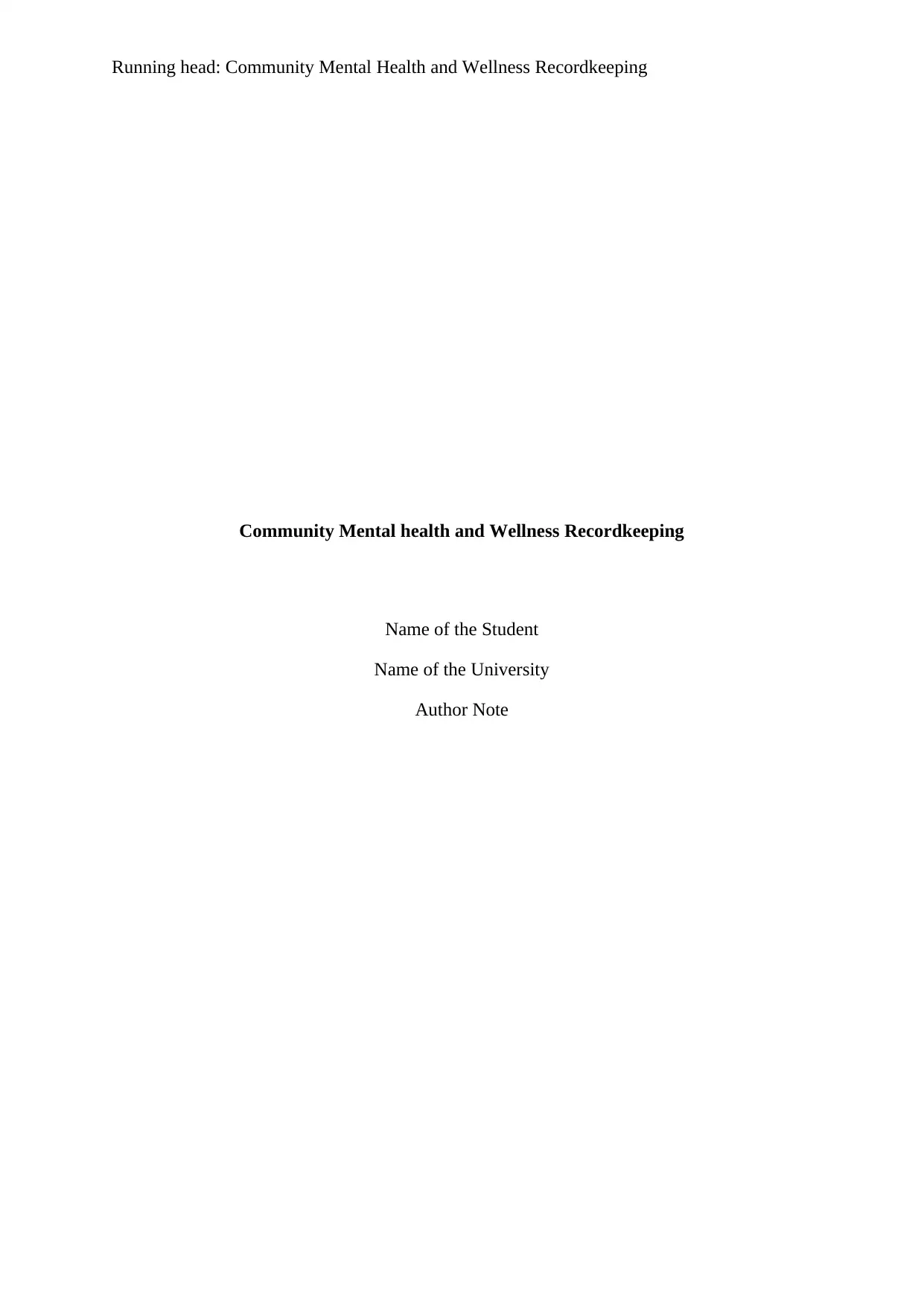
Running head: Community Mental Health and Wellness Recordkeeping
Community Mental health and Wellness Recordkeeping
Name of the Student
Name of the University
Author Note
Community Mental health and Wellness Recordkeeping
Name of the Student
Name of the University
Author Note
Paraphrase This Document
Need a fresh take? Get an instant paraphrase of this document with our AI Paraphraser
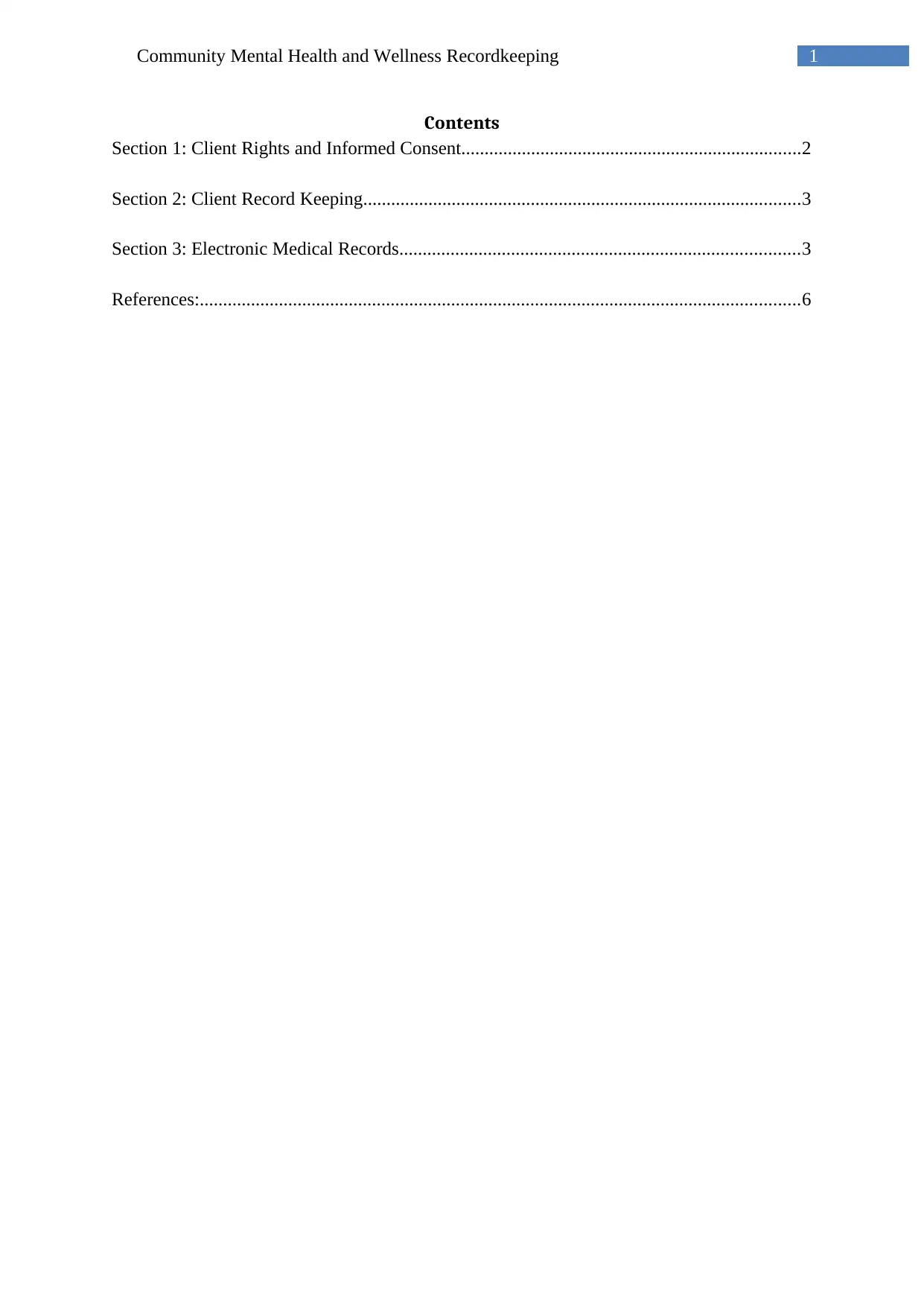
1Community Mental Health and Wellness Recordkeeping
Contents
Section 1: Client Rights and Informed Consent.........................................................................2
Section 2: Client Record Keeping..............................................................................................3
Section 3: Electronic Medical Records......................................................................................3
References:.................................................................................................................................6
Contents
Section 1: Client Rights and Informed Consent.........................................................................2
Section 2: Client Record Keeping..............................................................................................3
Section 3: Electronic Medical Records......................................................................................3
References:.................................................................................................................................6
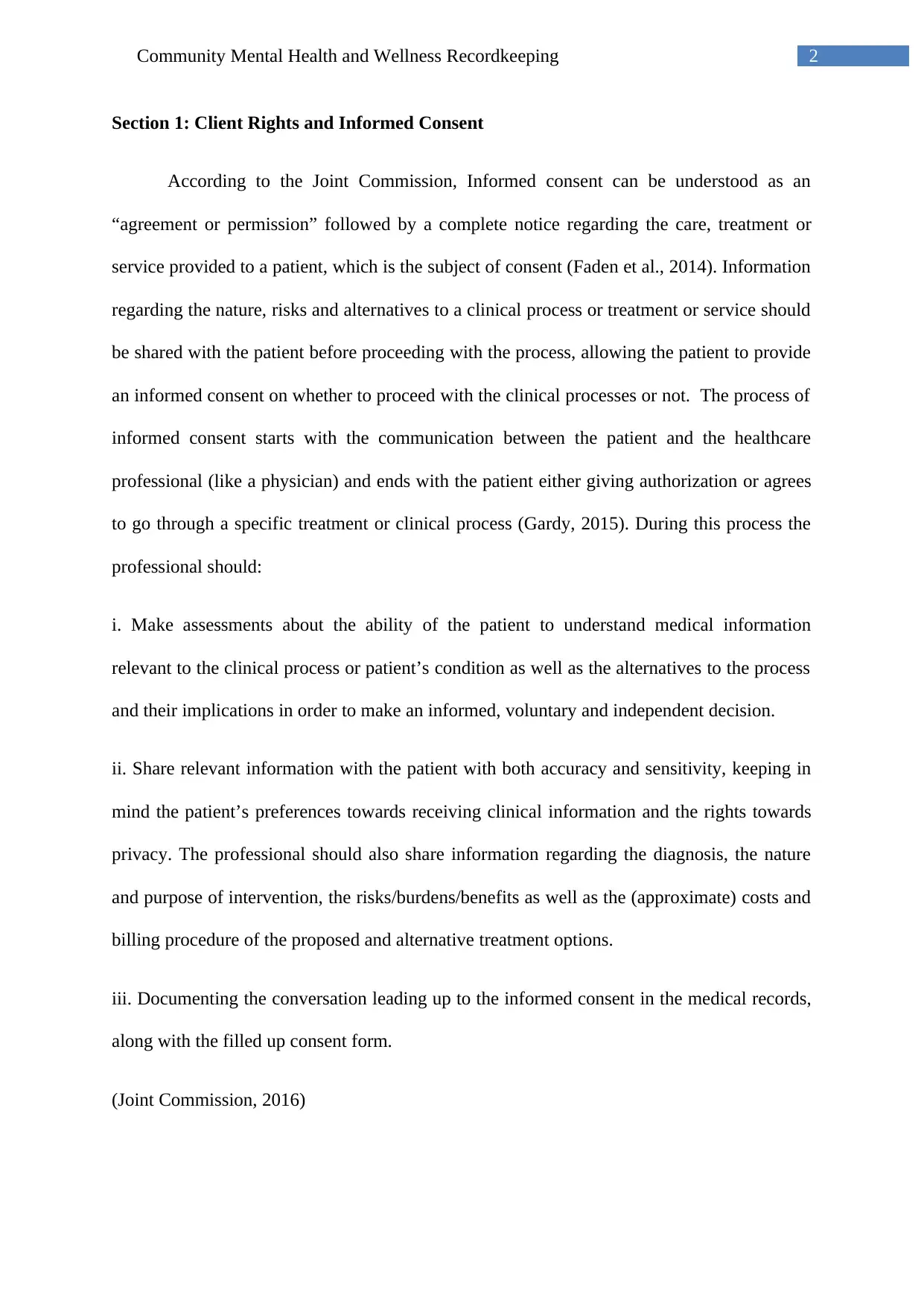
2Community Mental Health and Wellness Recordkeeping
Section 1: Client Rights and Informed Consent
According to the Joint Commission, Informed consent can be understood as an
“agreement or permission” followed by a complete notice regarding the care, treatment or
service provided to a patient, which is the subject of consent (Faden et al., 2014). Information
regarding the nature, risks and alternatives to a clinical process or treatment or service should
be shared with the patient before proceeding with the process, allowing the patient to provide
an informed consent on whether to proceed with the clinical processes or not. The process of
informed consent starts with the communication between the patient and the healthcare
professional (like a physician) and ends with the patient either giving authorization or agrees
to go through a specific treatment or clinical process (Gardy, 2015). During this process the
professional should:
i. Make assessments about the ability of the patient to understand medical information
relevant to the clinical process or patient’s condition as well as the alternatives to the process
and their implications in order to make an informed, voluntary and independent decision.
ii. Share relevant information with the patient with both accuracy and sensitivity, keeping in
mind the patient’s preferences towards receiving clinical information and the rights towards
privacy. The professional should also share information regarding the diagnosis, the nature
and purpose of intervention, the risks/burdens/benefits as well as the (approximate) costs and
billing procedure of the proposed and alternative treatment options.
iii. Documenting the conversation leading up to the informed consent in the medical records,
along with the filled up consent form.
(Joint Commission, 2016)
Section 1: Client Rights and Informed Consent
According to the Joint Commission, Informed consent can be understood as an
“agreement or permission” followed by a complete notice regarding the care, treatment or
service provided to a patient, which is the subject of consent (Faden et al., 2014). Information
regarding the nature, risks and alternatives to a clinical process or treatment or service should
be shared with the patient before proceeding with the process, allowing the patient to provide
an informed consent on whether to proceed with the clinical processes or not. The process of
informed consent starts with the communication between the patient and the healthcare
professional (like a physician) and ends with the patient either giving authorization or agrees
to go through a specific treatment or clinical process (Gardy, 2015). During this process the
professional should:
i. Make assessments about the ability of the patient to understand medical information
relevant to the clinical process or patient’s condition as well as the alternatives to the process
and their implications in order to make an informed, voluntary and independent decision.
ii. Share relevant information with the patient with both accuracy and sensitivity, keeping in
mind the patient’s preferences towards receiving clinical information and the rights towards
privacy. The professional should also share information regarding the diagnosis, the nature
and purpose of intervention, the risks/burdens/benefits as well as the (approximate) costs and
billing procedure of the proposed and alternative treatment options.
iii. Documenting the conversation leading up to the informed consent in the medical records,
along with the filled up consent form.
(Joint Commission, 2016)
⊘ This is a preview!⊘
Do you want full access?
Subscribe today to unlock all pages.

Trusted by 1+ million students worldwide
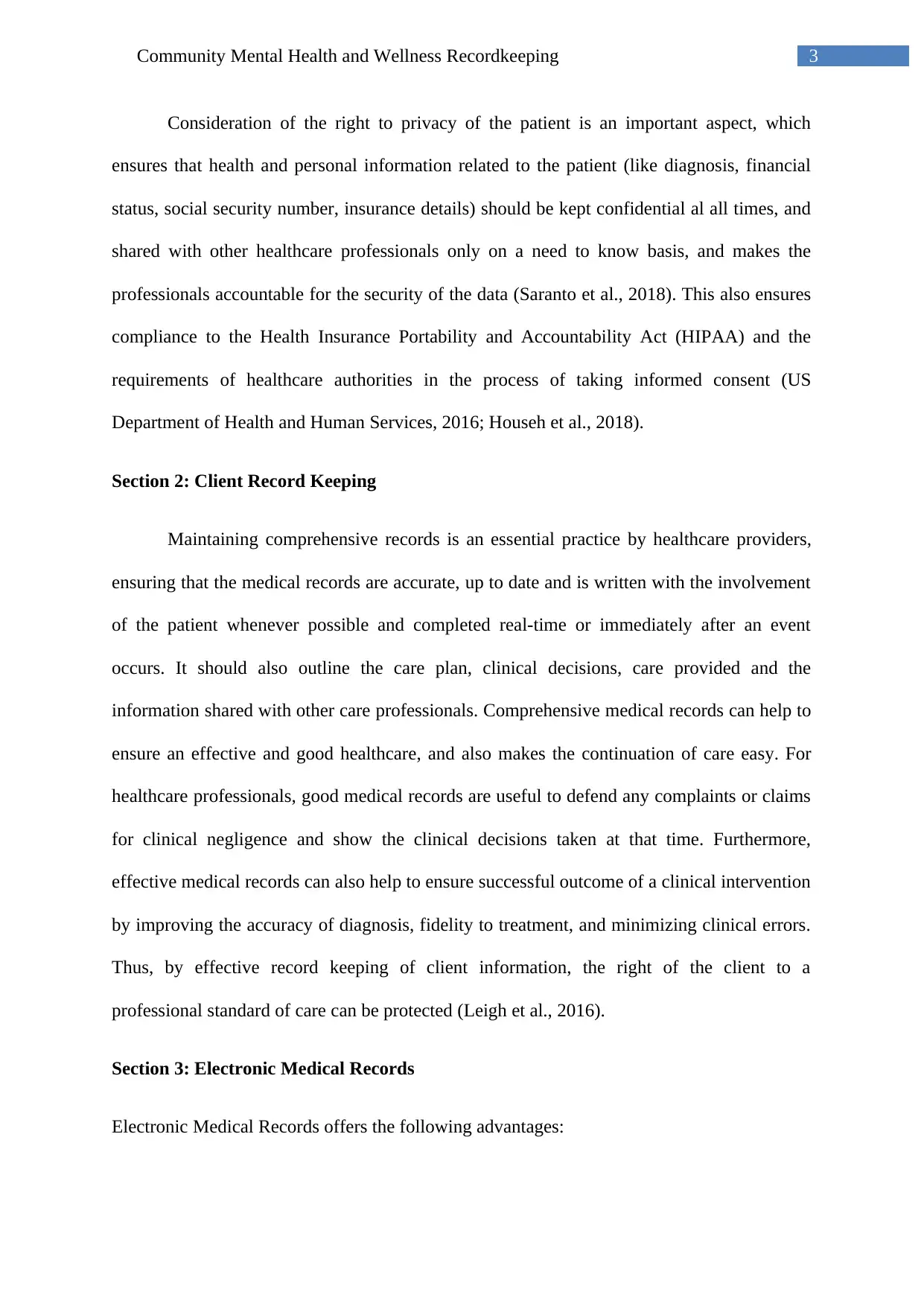
3Community Mental Health and Wellness Recordkeeping
Consideration of the right to privacy of the patient is an important aspect, which
ensures that health and personal information related to the patient (like diagnosis, financial
status, social security number, insurance details) should be kept confidential al all times, and
shared with other healthcare professionals only on a need to know basis, and makes the
professionals accountable for the security of the data (Saranto et al., 2018). This also ensures
compliance to the Health Insurance Portability and Accountability Act (HIPAA) and the
requirements of healthcare authorities in the process of taking informed consent (US
Department of Health and Human Services, 2016; Househ et al., 2018).
Section 2: Client Record Keeping
Maintaining comprehensive records is an essential practice by healthcare providers,
ensuring that the medical records are accurate, up to date and is written with the involvement
of the patient whenever possible and completed real-time or immediately after an event
occurs. It should also outline the care plan, clinical decisions, care provided and the
information shared with other care professionals. Comprehensive medical records can help to
ensure an effective and good healthcare, and also makes the continuation of care easy. For
healthcare professionals, good medical records are useful to defend any complaints or claims
for clinical negligence and show the clinical decisions taken at that time. Furthermore,
effective medical records can also help to ensure successful outcome of a clinical intervention
by improving the accuracy of diagnosis, fidelity to treatment, and minimizing clinical errors.
Thus, by effective record keeping of client information, the right of the client to a
professional standard of care can be protected (Leigh et al., 2016).
Section 3: Electronic Medical Records
Electronic Medical Records offers the following advantages:
Consideration of the right to privacy of the patient is an important aspect, which
ensures that health and personal information related to the patient (like diagnosis, financial
status, social security number, insurance details) should be kept confidential al all times, and
shared with other healthcare professionals only on a need to know basis, and makes the
professionals accountable for the security of the data (Saranto et al., 2018). This also ensures
compliance to the Health Insurance Portability and Accountability Act (HIPAA) and the
requirements of healthcare authorities in the process of taking informed consent (US
Department of Health and Human Services, 2016; Househ et al., 2018).
Section 2: Client Record Keeping
Maintaining comprehensive records is an essential practice by healthcare providers,
ensuring that the medical records are accurate, up to date and is written with the involvement
of the patient whenever possible and completed real-time or immediately after an event
occurs. It should also outline the care plan, clinical decisions, care provided and the
information shared with other care professionals. Comprehensive medical records can help to
ensure an effective and good healthcare, and also makes the continuation of care easy. For
healthcare professionals, good medical records are useful to defend any complaints or claims
for clinical negligence and show the clinical decisions taken at that time. Furthermore,
effective medical records can also help to ensure successful outcome of a clinical intervention
by improving the accuracy of diagnosis, fidelity to treatment, and minimizing clinical errors.
Thus, by effective record keeping of client information, the right of the client to a
professional standard of care can be protected (Leigh et al., 2016).
Section 3: Electronic Medical Records
Electronic Medical Records offers the following advantages:
Paraphrase This Document
Need a fresh take? Get an instant paraphrase of this document with our AI Paraphraser
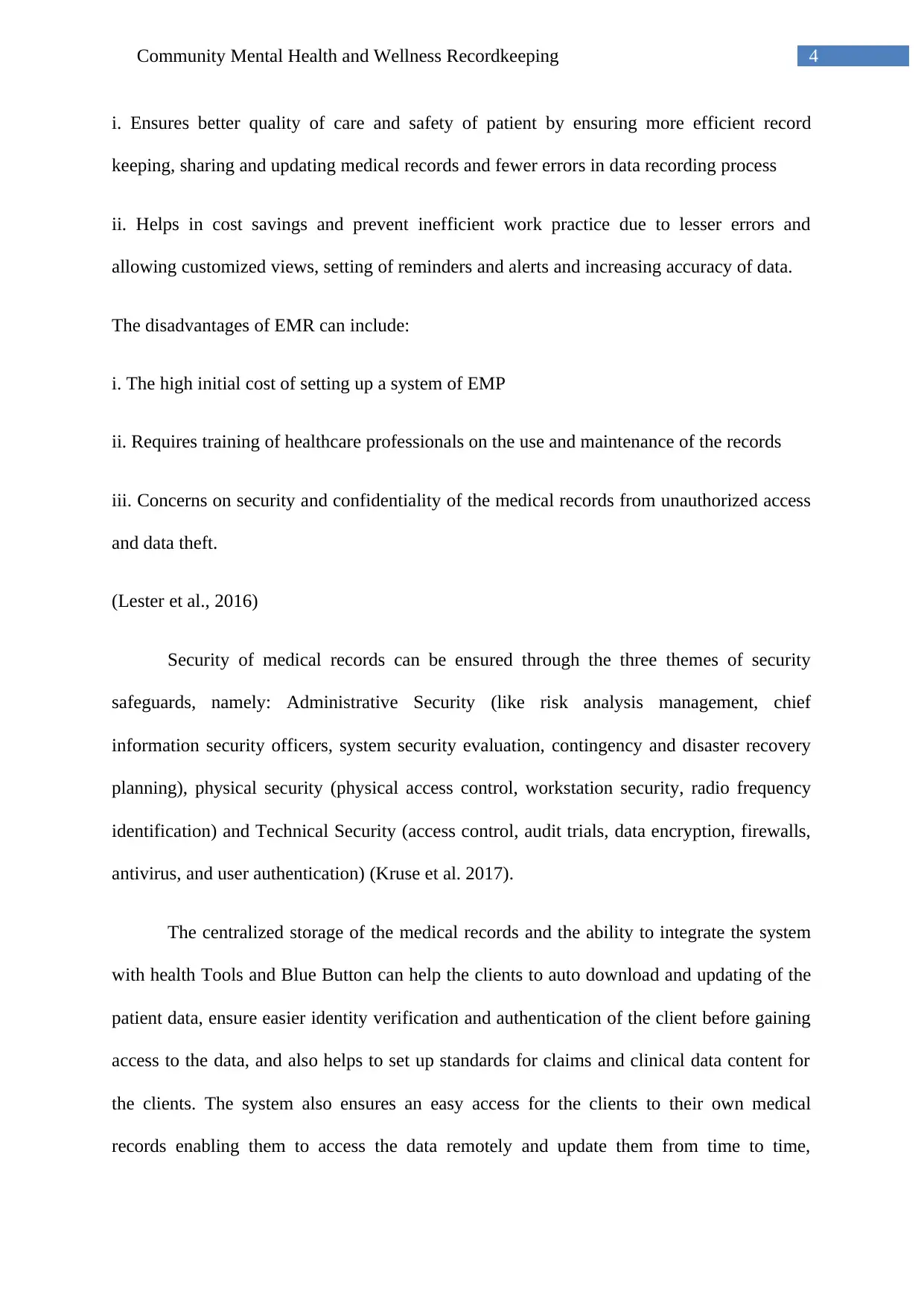
4Community Mental Health and Wellness Recordkeeping
i. Ensures better quality of care and safety of patient by ensuring more efficient record
keeping, sharing and updating medical records and fewer errors in data recording process
ii. Helps in cost savings and prevent inefficient work practice due to lesser errors and
allowing customized views, setting of reminders and alerts and increasing accuracy of data.
The disadvantages of EMR can include:
i. The high initial cost of setting up a system of EMP
ii. Requires training of healthcare professionals on the use and maintenance of the records
iii. Concerns on security and confidentiality of the medical records from unauthorized access
and data theft.
(Lester et al., 2016)
Security of medical records can be ensured through the three themes of security
safeguards, namely: Administrative Security (like risk analysis management, chief
information security officers, system security evaluation, contingency and disaster recovery
planning), physical security (physical access control, workstation security, radio frequency
identification) and Technical Security (access control, audit trials, data encryption, firewalls,
antivirus, and user authentication) (Kruse et al. 2017).
The centralized storage of the medical records and the ability to integrate the system
with health Tools and Blue Button can help the clients to auto download and updating of the
patient data, ensure easier identity verification and authentication of the client before gaining
access to the data, and also helps to set up standards for claims and clinical data content for
the clients. The system also ensures an easy access for the clients to their own medical
records enabling them to access the data remotely and update them from time to time,
i. Ensures better quality of care and safety of patient by ensuring more efficient record
keeping, sharing and updating medical records and fewer errors in data recording process
ii. Helps in cost savings and prevent inefficient work practice due to lesser errors and
allowing customized views, setting of reminders and alerts and increasing accuracy of data.
The disadvantages of EMR can include:
i. The high initial cost of setting up a system of EMP
ii. Requires training of healthcare professionals on the use and maintenance of the records
iii. Concerns on security and confidentiality of the medical records from unauthorized access
and data theft.
(Lester et al., 2016)
Security of medical records can be ensured through the three themes of security
safeguards, namely: Administrative Security (like risk analysis management, chief
information security officers, system security evaluation, contingency and disaster recovery
planning), physical security (physical access control, workstation security, radio frequency
identification) and Technical Security (access control, audit trials, data encryption, firewalls,
antivirus, and user authentication) (Kruse et al. 2017).
The centralized storage of the medical records and the ability to integrate the system
with health Tools and Blue Button can help the clients to auto download and updating of the
patient data, ensure easier identity verification and authentication of the client before gaining
access to the data, and also helps to set up standards for claims and clinical data content for
the clients. The system also ensures an easy access for the clients to their own medical
records enabling them to access the data remotely and update them from time to time,
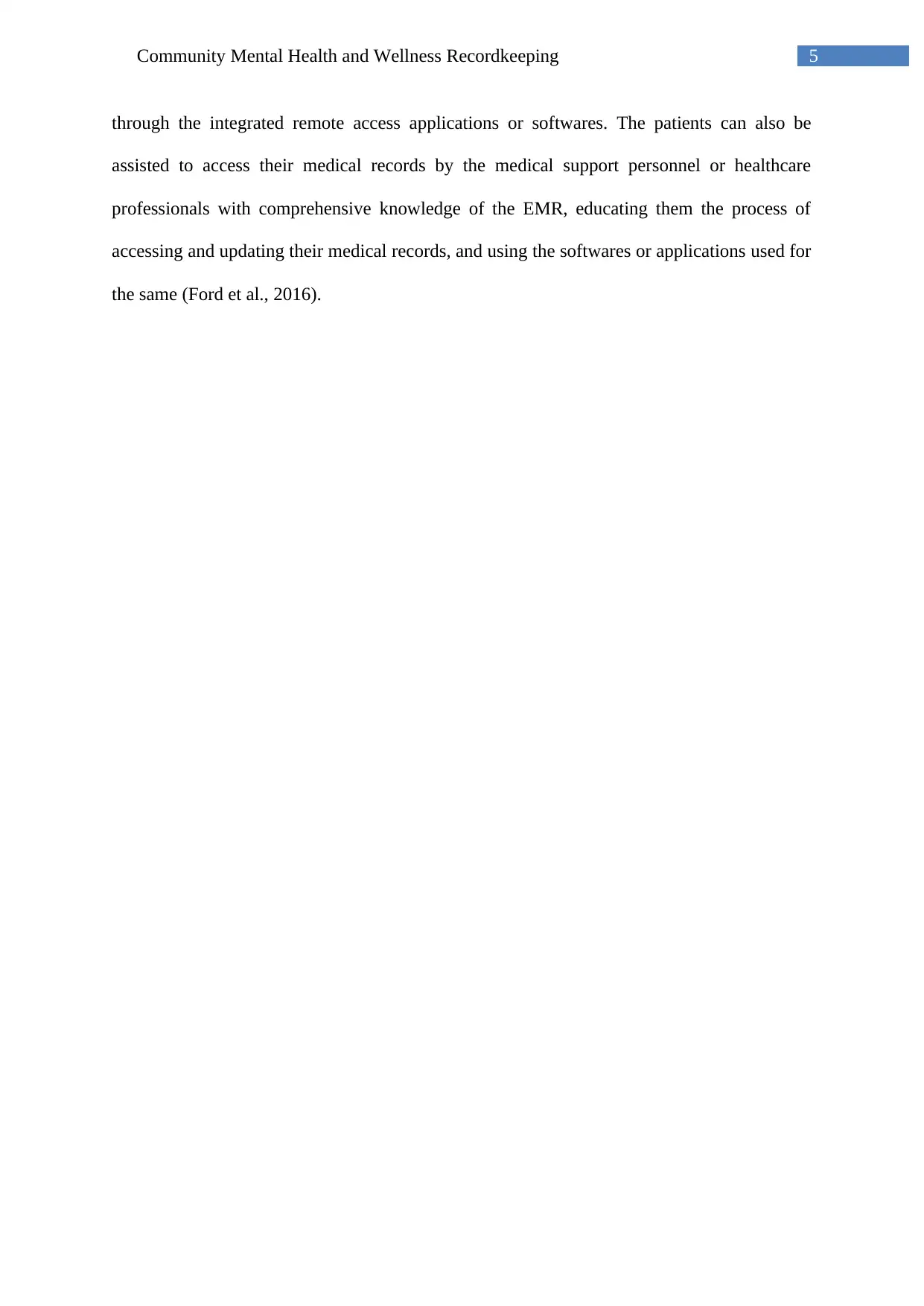
5Community Mental Health and Wellness Recordkeeping
through the integrated remote access applications or softwares. The patients can also be
assisted to access their medical records by the medical support personnel or healthcare
professionals with comprehensive knowledge of the EMR, educating them the process of
accessing and updating their medical records, and using the softwares or applications used for
the same (Ford et al., 2016).
through the integrated remote access applications or softwares. The patients can also be
assisted to access their medical records by the medical support personnel or healthcare
professionals with comprehensive knowledge of the EMR, educating them the process of
accessing and updating their medical records, and using the softwares or applications used for
the same (Ford et al., 2016).
⊘ This is a preview!⊘
Do you want full access?
Subscribe today to unlock all pages.

Trusted by 1+ million students worldwide
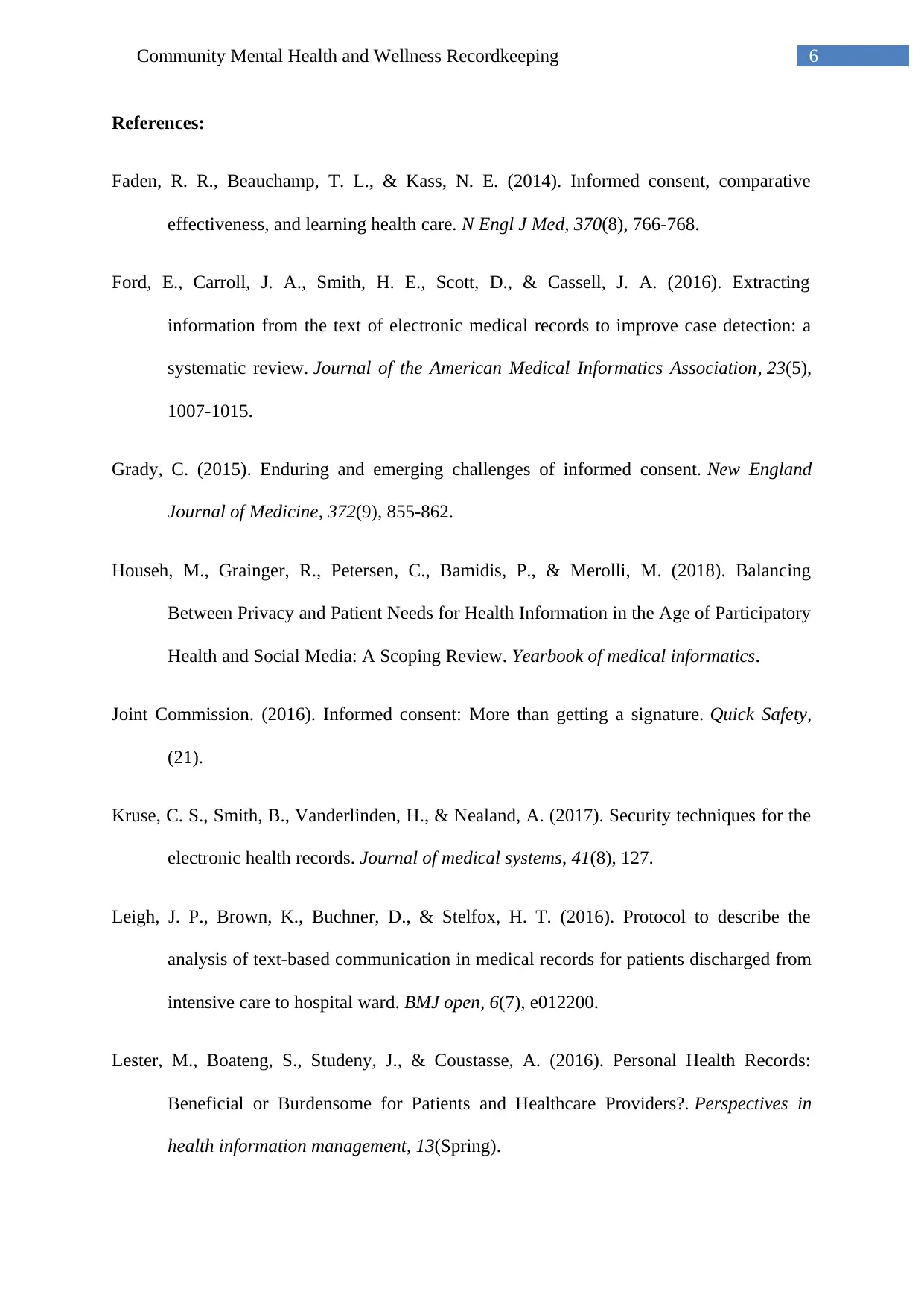
6Community Mental Health and Wellness Recordkeeping
References:
Faden, R. R., Beauchamp, T. L., & Kass, N. E. (2014). Informed consent, comparative
effectiveness, and learning health care. N Engl J Med, 370(8), 766-768.
Ford, E., Carroll, J. A., Smith, H. E., Scott, D., & Cassell, J. A. (2016). Extracting
information from the text of electronic medical records to improve case detection: a
systematic review. Journal of the American Medical Informatics Association, 23(5),
1007-1015.
Grady, C. (2015). Enduring and emerging challenges of informed consent. New England
Journal of Medicine, 372(9), 855-862.
Househ, M., Grainger, R., Petersen, C., Bamidis, P., & Merolli, M. (2018). Balancing
Between Privacy and Patient Needs for Health Information in the Age of Participatory
Health and Social Media: A Scoping Review. Yearbook of medical informatics.
Joint Commission. (2016). Informed consent: More than getting a signature. Quick Safety,
(21).
Kruse, C. S., Smith, B., Vanderlinden, H., & Nealand, A. (2017). Security techniques for the
electronic health records. Journal of medical systems, 41(8), 127.
Leigh, J. P., Brown, K., Buchner, D., & Stelfox, H. T. (2016). Protocol to describe the
analysis of text-based communication in medical records for patients discharged from
intensive care to hospital ward. BMJ open, 6(7), e012200.
Lester, M., Boateng, S., Studeny, J., & Coustasse, A. (2016). Personal Health Records:
Beneficial or Burdensome for Patients and Healthcare Providers?. Perspectives in
health information management, 13(Spring).
References:
Faden, R. R., Beauchamp, T. L., & Kass, N. E. (2014). Informed consent, comparative
effectiveness, and learning health care. N Engl J Med, 370(8), 766-768.
Ford, E., Carroll, J. A., Smith, H. E., Scott, D., & Cassell, J. A. (2016). Extracting
information from the text of electronic medical records to improve case detection: a
systematic review. Journal of the American Medical Informatics Association, 23(5),
1007-1015.
Grady, C. (2015). Enduring and emerging challenges of informed consent. New England
Journal of Medicine, 372(9), 855-862.
Househ, M., Grainger, R., Petersen, C., Bamidis, P., & Merolli, M. (2018). Balancing
Between Privacy and Patient Needs for Health Information in the Age of Participatory
Health and Social Media: A Scoping Review. Yearbook of medical informatics.
Joint Commission. (2016). Informed consent: More than getting a signature. Quick Safety,
(21).
Kruse, C. S., Smith, B., Vanderlinden, H., & Nealand, A. (2017). Security techniques for the
electronic health records. Journal of medical systems, 41(8), 127.
Leigh, J. P., Brown, K., Buchner, D., & Stelfox, H. T. (2016). Protocol to describe the
analysis of text-based communication in medical records for patients discharged from
intensive care to hospital ward. BMJ open, 6(7), e012200.
Lester, M., Boateng, S., Studeny, J., & Coustasse, A. (2016). Personal Health Records:
Beneficial or Burdensome for Patients and Healthcare Providers?. Perspectives in
health information management, 13(Spring).
Paraphrase This Document
Need a fresh take? Get an instant paraphrase of this document with our AI Paraphraser
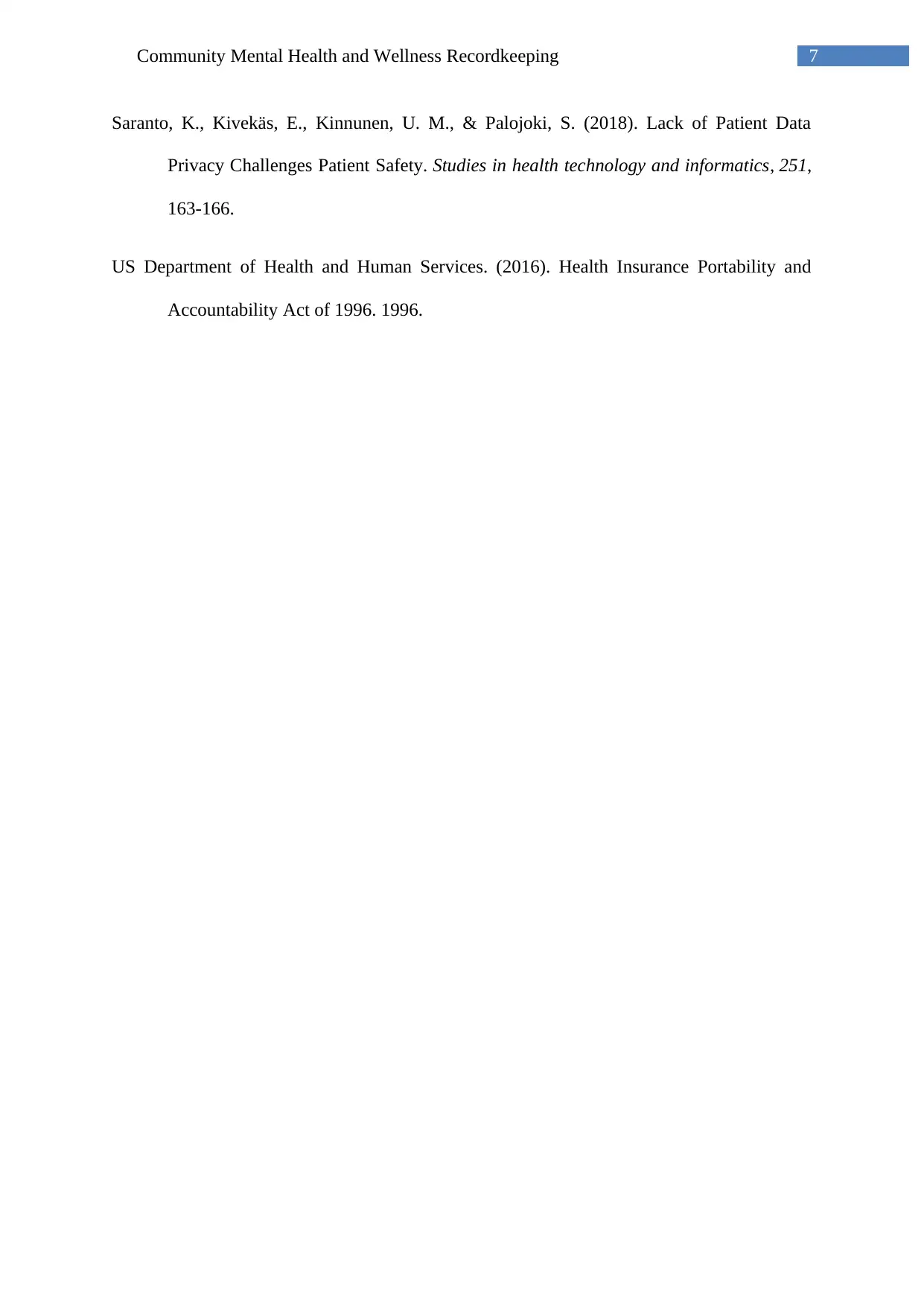
7Community Mental Health and Wellness Recordkeeping
Saranto, K., Kivekäs, E., Kinnunen, U. M., & Palojoki, S. (2018). Lack of Patient Data
Privacy Challenges Patient Safety. Studies in health technology and informatics, 251,
163-166.
US Department of Health and Human Services. (2016). Health Insurance Portability and
Accountability Act of 1996. 1996.
Saranto, K., Kivekäs, E., Kinnunen, U. M., & Palojoki, S. (2018). Lack of Patient Data
Privacy Challenges Patient Safety. Studies in health technology and informatics, 251,
163-166.
US Department of Health and Human Services. (2016). Health Insurance Portability and
Accountability Act of 1996. 1996.
1 out of 8
Related Documents
Your All-in-One AI-Powered Toolkit for Academic Success.
+13062052269
info@desklib.com
Available 24*7 on WhatsApp / Email
![[object Object]](/_next/static/media/star-bottom.7253800d.svg)
Unlock your academic potential
Copyright © 2020–2025 A2Z Services. All Rights Reserved. Developed and managed by ZUCOL.





